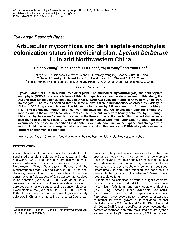摘要
Lycium barbarum L. is an oriental medicinal plant. The arbuscular mycorrhizal (AM) and dark septate endophytic (DSE) fungal associations of this plant species are completely unknown. In this study, the AM and DSE fungal colonization status in three L. barbarum cultivars in arid Northwestern China were investigated. The results showed that the three cultivars were simultaneously colonized by Paris-type AM and DSE fungal associations. The highest colonization by AM was found in L. barbarum Ningqi No.1. The significant "month" and "cultivar" indicates that the AM colonization changed among the months within the cultivar. Meanwhile, roots of the three cultivars were heavily colonized by DSE fungi. Melanized hyphae were frequently observed in the three cultivars. Microsclerotia of varied shapes were also found in the cortex cells of L. barbarum. Hyaline hyphae were most abundant in August but their occurrence decreased in December. Lipid contents were abundant in hyaline hyphae, and changed with month. Lipid may act as energy material reserves to sustain the survival of DSE-host symbioses under drought environmental conditions.
- 出版日期2010-9-18
- 单位西北农林科技大学
